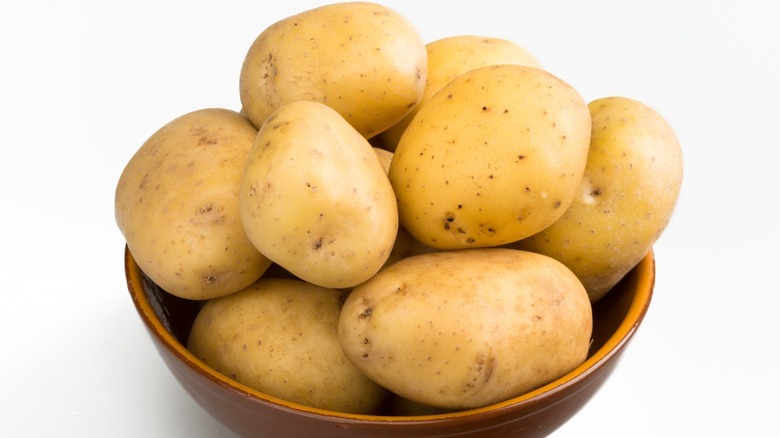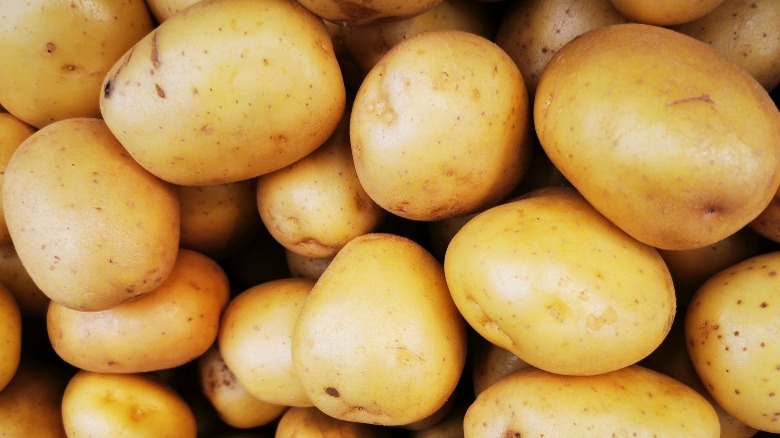The Absolute Best Way To Store Yukon Gold Potatoes
Is there anything better than a buttery, golden-hued Yukon Gold potato to whip up a creamy mashed colcannon, or stand up to the bright, sharp flavors of a tangy mustard potato salad, or elevate crispy twice-fried French fries to a truly epic snack?
Nope.
Round, flat-ish, and yellow-brown in color, these tubers have an early to mid-spring season start; they can be sown as soon as the soil reaches 45º Fahrenheit, according to Home for the Harvest. While it generally takes 90 to 100 days for Yukon Gold potato plants to fully mature, you can harvest smaller new potatoes earlier, at around the 70-day mark or so. This means they're often getting planted in March in drier areas and in May in wetter, colder climates, with their full harvest season happening in late August to September. Just in time to pair up with fall's other luscious bounties like cauliflower, Brussels sprouts, and kale (per HGTV). And because of Yukon gold's mildly waxy texture (per HuffPost), they hold up well in soups, chowders, and hasselback preparations. But as Robert Frost once pontificated, "Nothing gold can stay," so what's the best way to keep your Yukons fresh down to the very last fry?
How to keep Yukon Gold potatoes fresh
First developed at the University of Guelph, Ontario, Canada in 1966 but not released to the marketplace until 1980 (via Institute of Agriculture and Natural Resources University of Nebraska), Yukon Gold potatoes are a hybrid of a South American yellow potato and a North American white variety (per Harvest to Table). Because of their higher sugar content, Yukon Golds can be a bit fussier to store and keep fresh. Horticulturist, master gardener, and podcaster Stephen Albert of Harvest to Table recommends storing them in a dark, cool place with good ventilation.
But don't make it too cool. Albert suggests 40–50º Fahrenheit (he cautions against going below 33ºF). Storage below that threshold turns the Yukon Gold's starch to sugar, in what Healthline refers to as "reducing sugars." When heated at high temperatures, these reducing sugars can react with amino acids and result in the creation of a carcinogenic substance called acrylamide, according to a study published in Nature.
Want these golden-hued beauties to last? Keep your potatoes and onions separate — at least until it's time to prepare them. Though these underground veggies love chilling in the same conditions, they don't play nicely together. In fact, storing your Yukon Golds near ripening produce such as apples, tomatoes, and bananas (all big producers of ethylene) can be a recipe for disaster, reducing their lifespans and causing your Yukon Golds to sprout and even rot at a more accelerated rate (via Martha Stewart).
Banish the green to keep the golds
Keeping your Golds fresh in a cool, dark environment, away from off-gassing offenders, goes beyond preventing rot. It also reduces your risk of green potato poisoning (per Smithsonian Magazine). Green potatoes are the result of exposure to light. That green tinge is chlorophyll, the harmless substance responsible for greening a potato plant's stems and leaves. But it does act as an early tater toxin warning system, alerting you to the presence of a more insidious, naturally occurring substance called solanine, a glycoalkaloid that concurrently increases with too much light exposure (per Poison Control). Both low and high amounts of solanine can cause a spectrum of symptoms from mild to dangerous, everything from a lightly upset tummy and stomach cramps, to burning throat, headache, and dizziness, to more chronic presentations of nausea, diarrhea, and vomiting (via The Conversation). In rare cases, even death occurs according to Poison Control, depending on the amount of solanine ingested.
The good news is that by storing your Yukon Golds in a cool, dark, well-ventilated area, you'll avoid solanine and keep your taters fresh for longer, and the USDA says you don't have to throw out your luscious golds just because of a little green. To avoid the negative effects of solanine, simply peel the skins and sprouts, removing any green (where solanine is concentrated) and enjoy!


